Water Vulnerability in Dhaka, Narayanganj, and Gazipur Districts of Bangladesh: The Role of Textile Dye Production
Abstract
1. Introduction
2. Existing Literature
2.1. Textile Dye Contamination of Dhaka’s Rivers
2.2. Impact on Broader Society
2.3. Research Relevance
3. Data and Methods
3.1. River Water Quality
3.2. Water Insecurity and Vulnerability
3.3. Water Vulnerability Index
4. Results
4.1. River Water Pollution in Dhaka, Gazipur, and Narayanganj
4.2. Access to Basic Drinking Water
4.3. Water Vulnerability Index (WVI)
4.3.1. Demographic Dimension of WVI
4.3.2. Socioeconomic Dimension of WVI
4.3.3. Gender Dimension of WVI
4.3.4. WASH Dimension of WVI
4.3.5. Health Dimension of WVI
4.3.6. Climate Dimension of WVI
4.3.7. WVI
5. Discussion
5.1. River Pollution, Water Insecurity, and Water Vulnerability Index
5.2. Policy Recommendations
6. Conclusions
Supplementary Materials
Author Contributions
Funding
Data Availability Statement
Acknowledgments
Conflicts of Interest
References
- IPCC. Climate Change 2022—Impacts, Adaptation and Vulnerability. In Summary for Policymakers; Pörtner, H.-O., Roberts, D.C., Poloczanska, E.S., Mintenbeck, K., Tignor, M., Alegría, A., Craig, M., Langsdorf, S., Löschke, S., Möller, V., et al., Eds.; Cambridge University Press: Cambridge, UK, 2023; pp. 3–34. [Google Scholar]
- Ramli, M.W.A.; Alias, N.E.; Yusof, H.M.; Yusop, Z.; Taib, S.M.; Wahab, Y.F.A.; Hassan, S.A. Spatial multidimensional vulnerability assessment index in urban area—A case study Selangor, Malaysia. Prog. Disaster Sci. 2023, 20, 100296. [Google Scholar] [CrossRef]
- Whitehead, P.G.; Bussi, G.; Peters, R.; Hossain, M.A.; Softley, L.; Shawal, S.; Jin, L.; Rampley, C.P.N.; Holdship, P.; Hope, R.; et al. Modelling heavy metals in the Buriganga River System, Dhaka, Bangladesh: Impacts of tannery pollution control. Sci. Total Environ. 2019, 697, 134090. [Google Scholar] [CrossRef] [PubMed]
- Uddin, M.d.J.; Jeong, Y.K. Urban river pollution in Bangladesh during last 40 years: Potential public health and ecological risk, present policy, and future prospects toward smart water management. Heliyon 2021, 7, e06107. [Google Scholar] [CrossRef] [PubMed]
- MacAlister, C.; Baggio, G.; Perera, D.; Qadir, M.; Taing, L.; Smakhtin, V. Global Water Security 2023 Assessment. 2023. UNU-INWEH. Available online: https://collections.unu.edu/eserv/UNU:9107/n23-116_UNU_Water_Security_WEB_Final_updated.pdf (accessed on 31 July 2025).
- Persson, L.; Carney Almroth, B.M.; Collins, C.D.; Cornell, S.; de Wit, C.A.; Diamond, M.L.; Fantke, P.; Hassellöv, M.; MacLeod, M.; Ryberg, M.W.; et al. Outside the Safe Operating Space of the Planetary Boundary for Novel Entities. Environ. Sci. Technol. 2022, 56, 1510–1521. [Google Scholar] [CrossRef]
- UNEP. Global Chemicals Outlook II: From Legacies to Innovative Solutions: Implementing the 2030 Agenda for Sustainable Development. 2019. Available online: https://wedocs.unep.org/2050011822/34184 (accessed on 3 June 2025).
- Shittu, E.; Lakhanpaul, M.; Vigurs, C.; Sarkar, K.; Koch, M.; Parikh, P.; Campos, L.C. A rapid systematic scoping review of research on the impacts of water contaminated by chemicals on very young children. Sci. Total Environ. 2023, 891, 164604. [Google Scholar] [CrossRef]
- Richardson, K.; Steffen, W.; Lucht, W.; Bendtsen, J.; Cornell, S.E.; Donges, J.F.; Drüke, M.; Fetzer, I.; Bala, G.; von Bloh, W.; et al. Earth beyond six of nine planetary boundaries. Sci. Adv. 2023, 9, eadh2458. [Google Scholar] [CrossRef]
- Uddin, M.A.; Begum, M.S.; Ashraf, M.; Azad, A.K.; Adhikary, A.C.; Hossain, M.S. Water and chemical consumption in the textile processing industry of Bangladesh. PLOS Sustain. Transform. 2023, 2, e0000072. [Google Scholar] [CrossRef]
- UNEP. Textile-Producing Nations Unite to Reduce Chemical Waste. 2022. Available online: https://www.unep.org/news-and-stories/press-release/textile-producing-nations-unite-reduce-chemical-waste (accessed on 4 June 2025).
- Quantis. Measuring Fashion. Environmental Impact of the Global Apparel and Footwear Industries Study. 2018. Available online: https://quantis.com/wp-content/uploads/2018/03/measuringfashion_globalimpactstudy_full-report_quantis_cwf_2018a.pdf (accessed on 27 May 2025).
- OEC. Textiles in Bangladesh. 2025. Available online: https://oec.world/en/profile/bilateral-product/textiles/reporter/bgd?redirect=true (accessed on 28 May 2025).
- Hoque, S.F.; Peters, R.; Whitehead, P.; Hope, R.; Hossain, M.A. River pollution and social inequalities in Dhaka, Bangladesh. Environ. Res. Commun. 2021, 3, 095003. [Google Scholar] [CrossRef]
- Chakraborty, R.; Ahmad, F. Economical use of water in cotton knit dyeing industries of Bangladesh. J. Clean. Prod. 2022, 340, 130825. [Google Scholar] [CrossRef]
- Water Aid. Water. 2025. Available online: https://www.wateraid.org/bd/the-crisis/water (accessed on 2 June 2025).
- Kuzma, S.; Bierkens, M.F.P.; Lakshman, S.; Luo, T.; Saccoccia, L.; Sutanudjaja, E.H.; Van Beek, R. Aqueduct 4.0: Updated Decision-Relevant Global Water Risk Indicators; World Resources Institute (WRI): Washington, DC, USA, 2023. [Google Scholar]
- OhIsson, L. Water conflicts and social resource scarcity. Phys. Chem. Earth Part B Hydrol. Ocean. Atmos. 2000, 25, 213–220. [Google Scholar] [CrossRef]
- El Garouani, M.; Radoine, H.; Lahrach, A.; Oulidi, H.J.; Chaabane, M.S. An integrated and multidimensional approach for analyzing vulnerability of water resources under territorial climate conditions. Environ. Sustain. Indic. 2024, 22, 100383. [Google Scholar] [CrossRef]
- Sullivan, C. Calculating a Water Poverty Index. World Dev. 2002, 30, 1195–1210. [Google Scholar] [CrossRef]
- Jaren, L.S.; Mondal, M.S. Assessing Water Poverty of Livelihood Groups in Peri-Urban Areas around Dhaka under a Changing Environment. Water 2021, 13, 2674. [Google Scholar] [CrossRef]
- Ahsan, A.; Ahmed, T.; Uddin, M.A.; Al-Sulttani, A.O.; Shafiquzzaman, M.; Islam, M.R.; Ahmed, M.S.; Alamin; Mohadesh, M.; Haque, M.N.; et al. Evaluation of Water Quality Index (WQI) in and around Dhaka City Using Groundwater Quality Parameters. Water 2023, 15, 2666. [Google Scholar] [CrossRef]
- Hasan, M.; Islam, M.d.A.; Aziz Hasan, M.; Alam, M.d.J.; Peas, M.H. Groundwater vulnerability assessment in Savar upazila of Dhaka district, Bangladesh—A GIS-based DRASTIC modeling. Groundw. Sustain. Dev. 2019, 9, 100220. [Google Scholar] [CrossRef]
- Alam, R.; Quayyum, Z.; Moulds, S.; Radia, M.A.; Sara, H.H.; Hasan, M.T.; Butler, A. Dhaka city water logging hazards: Area identification and vulnerability assessment through GIS-remote sensing techniques. Environ. Monit. Assess. 2023, 195, 543. [Google Scholar] [CrossRef] [PubMed]
- Chowdhury, K.J.; Ali, M.R.; Chowdhury, M.A.; Islam, S.L.U. Climate change induced risks assessment of a coastal area: A “socioeconomic and livelihood vulnerability index” based study in coastal Bangladesh. Nat. Hazards Res. 2025, 5, 75–87. [Google Scholar] [CrossRef]
- Sarkar, S.K.; Das, S.; Rudra, R.R.; Ekram, K.M.M.; Haydar, M.; Alam, E.; Islam, K.; Islam, A.R.M.T. Delineating the drought vulnerability zones in Bangladesh. Sci. Rep. 2024, 14, 25564. [Google Scholar] [CrossRef] [PubMed]
- Sarkar, R.; Vogt, J. Drinking water vulnerability in rural coastal areas of Bangladesh during and after natural extreme events. Int. J. Disaster Risk Reduct. 2015, 14, 411–423. [Google Scholar] [CrossRef]
- Bangladesh Department of Environment. Surface and Ground Water Quality Report 2023. 2023. Available online: https://doe.portal.gov.bd/sites/default/files/files/doe.portal.gov.bd/publications/edc0f4f2_8346_4f58_bdd1_72978984ba3e/2024-08-27-08-00-a698975451058b1fc83366d454942747.pdf (accessed on 25 May 2025).
- European Commission DRMKC—INFORM. Bangladesh: INFORM Subnational Model of Bangladesh. 2024. Available online: https://drmkc.jrc.ec.europa.eu/inform-index/INFORM-Subnational-Risk/Bangladesh (accessed on 16 May 2025).
- Dutta, S.; Adhikary, S.; Bhattacharya, S.; Roy, D.; Chatterjee, S.; Chakraborty, A.; Banerjee, D.; Ganguly, A.; Nanda, S.; Rajak, P. Contamination of textile dyes in aquatic environment: Adverse impacts on aquatic ecosystem and human health, and its management using bioremediation. J. Environ. Manag. 2024, 353, 120103. [Google Scholar] [CrossRef]
- Al-Tohamy, R.; Ali, S.S.; Li, F.; Okasha, K.M.; Mahmoud, Y.A.G.; Elsamahy, T.; Jiao, H.; Fu, Y.; Sun, J. A critical review on the treatment of dye-containing wastewater: Ecotoxicological and health concerns of textile dyes and possible remediation approaches for environmental safety. Ecotoxicol. Environ. Saf. 2022, 231, 113160. [Google Scholar] [CrossRef] [PubMed]
- Islam, T.; Repon, M.R.; Islam, T.; Sarwar, Z.; Rahman, M.M. Impact of textile dyes on health and ecosystem: A review of structure, causes, and potential solutions. Environ. Sci. Pollut. Res. 2023, 30, 9207–9242. [Google Scholar] [CrossRef] [PubMed]
- Sharma, J.; Sharma, S.; Soni, V. Classification and impact of synthetic textile dyes on Aquatic Flora: A review. Reg. Stud. Mar. Sci. 2021, 45, 101802. [Google Scholar] [CrossRef]
- Hossen, M.d.A.; Mostafa, M.G. Assessment of heavy metal pollution in surface water of Bangladesh. Environ. Chall. 2023, 13, 100783. [Google Scholar] [CrossRef]
- Uddin, M.; Alam, F.B. Health risk assessment of the heavy metals at wastewater discharge points of textile industries in Tongi, Shitalakkhya, and Dhaleshwari, Bangladesh. J. Water Health 2023, 21, 586–600. [Google Scholar] [CrossRef] [PubMed]
- Uddin, M.; Kormoker, T.; Siddique, M.d.A.B.; Billah, M.M.; Rokonuzzaman, M.; Al Ragib, A.; Proshad, R.; Hossain, Y.; Haque, K.; Ibrahim, K.A.; et al. An overview on water quality, pollution sources, and associated ecological and human health concerns of the lake water of megacity: A case study on Dhaka city lakes in Bangladesh. Urban Water J. 2023, 20, 261–277. [Google Scholar] [CrossRef]
- Yaseen, D.A.; Scholz, M. Textile dye wastewater characteristics and constituents of synthetic effluents: A critical review. Int. J. Environ. Sci. Technol. 2019, 16, 1193–1226. [Google Scholar] [CrossRef]
- Shindhal, T.; Rakholiya, P.; Varjani, S.; Pandey, A.; Ngo, H.H.; Guo, W.; Yong, H.; Taherzadeh, M.J. A critical review on advances in the practices and perspectives for the treatment of dye industry wastewater. Bioengineered 2021, 12, 70–87. [Google Scholar] [CrossRef]
- Mehra, S.; Singh, M.; Chadha, P. Adverse impact of textile dyes on the aquatic environment as well as on human beings. Toxicol. Int. 2021, 28, 165–176. [Google Scholar] [CrossRef]
- Morales-McDevitt, M.E.; Dunn, M.; Habib, A.; Vojta, S.; Becanova, J.; Lohmann, R. Poly- and Perfluorinated Alkyl Substances in Air and Water from Dhaka, Bangladesh. Environ. Toxicol. Chem. 2022, 41, 334–342. [Google Scholar] [CrossRef]
- Hossain, L.; Sarker, S.K.; Khan, M.S. Evaluation of present and future wastewater impacts of textile dyeing industries in Bangladesh. Environ. Dev. 2018, 26, 23–33. [Google Scholar] [CrossRef]
- Lellis, B.; Fávaro-Polonio, C.Z.; Pamphile, J.A.; Polonio, J.C. Effects of textile dyes on health and the environment and bioremediation potential of living organisms. Biotechnol. Res. Innov. 2019, 3, 275–290. [Google Scholar] [CrossRef]
- Nahar, N.; Haque, M.d.S.; Haque, S.E. Groundwater conservation, and recycling and reuse of textile wastewater in a denim industry of Bangladesh. Water Resour. Ind. 2024, 31, 100249. [Google Scholar] [CrossRef]
- Shamsuzzaman, M.; Kashem, M.d.A.; Muhammad Sayem, A.S.; Khan, A.M.; Shamsuddin, S.M.d.; Islam, M.M. Quantifying environmental sustainability of denim garments washing factories through effluent analysis: A case study in Bangladesh. J. Clean. Prod. 2021, 290, 125740. [Google Scholar] [CrossRef]
- Hussain, T.; Wahab, A. A critical review of the current water conservation practices in textile wet processing. J. Clean. Prod. 2018, 198, 806–819. [Google Scholar] [CrossRef]
- Rashid, H.; Rahman, M.; Rahman, M.; Talha, M. Determination of Water Quality Beside the Industrial Area of Turag River in Dhaka, Bangladesh. 2024. Available online: https://eartharxiv.org/repository/view/8019/ (accessed on 30 July 2025).
- Yin, H.; Islam, M.S.; Ju, M. Urban river pollution in the densely populated city of Dhaka, Bangladesh: Big picture and rehabilitation experience from other developing countries. J. Clean. Prod. 2021, 321, 129040. [Google Scholar] [CrossRef]
- Khan, W.U.; Ahmed, S.; Dhoble, Y.; Madhav, S. A critical review of hazardous waste generation from textile industries and associated ecological impacts. J. Indian Chem. Soc. 2023, 100, 100829. [Google Scholar] [CrossRef]
- Palacios-Mateo, C.; van der Meer, Y.; Seide, G. Analysis of the polyester clothing value chain to identify key intervention points for sustainability. Environ. Sci. Eur. 2021, 33, 2. [Google Scholar] [CrossRef] [PubMed]
- Sarkar, A. Minimalonomics: A novel economic model to address environmental sustainability and earth’s carrying capacity. J. Clean. Prod. 2022, 371, 133663. [Google Scholar] [CrossRef]
- Quattri, M.; Watkins, K. Child labour and education—A survey of slum settlements in Dhaka (Bangladesh). World Dev. Perspect. 2019, 13, 50–66. [Google Scholar] [CrossRef]
- International Labour Organization (ILO). Vulnerabilities to Child Labour. 2022. Available online: https://www.ilo.org/sites/default/files/wcmsp5/groups/public/%40ed_norm/%40ipec/documents/publication/wcms_845129.pdf (accessed on 1 August 2025).
- Caleo, G.; Sadique, S.; Yuce, D.; Dada, M.; Benvenuti, B.; Joseph, J.; Malden, D.; Velivela, K.; Chowdhury, S.M.; Mayienga, C.; et al. A Public health wound: Health and work among children engaged in the worst forms of child labour in the informal sector in Dhaka, Bangladesh: A retrospective analysis of Médecins Sans Frontières occupational health data from 2014 to 2023. BMC Public Health 2025, 25, 1420. [Google Scholar] [CrossRef] [PubMed]
- Chowdhury, M.d.A.; Nowreen, S.; Tarin, N.J.; Hasan, M.d.R.; Zzaman, R.U.; Amatullah, N.I. WASH and MHM experiences of disabled females living in Dhaka slums of Bangladesh. J. Water Sanit. Hyg. Dev. 2022, 12, 683–697. [Google Scholar] [CrossRef]
- Intesar, A.; Parvez, M.S. Living with vulnerability: Triple burden through the eyes of urban slum women in Bangladesh. Soc. Sci. Humanit. Open 2024, 10, 101014. [Google Scholar] [CrossRef]
- Gibbs, A.; Jewkes, R.; Willan, S.; Al Mamun, M.; Parvin, K.; Yu, M.; Naved, R. Workplace violence in Bangladesh’s garment industry. Soc. Sci. Med. 2019, 235, 112383. [Google Scholar] [CrossRef]
- Hossain, M.; Asadullah, M.N.; Kambhampati, U. Empowerment and life satisfaction: Evidence from Bangladesh. World Dev. 2019, 122, 170–183. [Google Scholar] [CrossRef]
- Brouwer, R.; Sharmin, D.F.; Elliott, S.; Liu, J.; Khan, M.R. Costs and benefits of improving water and sanitation in slums and non-slum neighborhoods in Dhaka, a fast-growing mega-city. Ecol. Econ. 2023, 207, 107763. [Google Scholar] [CrossRef]
- Cole, S.; Tallman, P.; Salmon-Mulanovich, G.; Rusyidi, B. Water insecurity is associated with gender-based violence: A mixed-methods study in Indonesia. Soc. Sci. Med. 2024, 344, 116507. [Google Scholar] [CrossRef]
- Kayser, G.; Rao, N.; Jose, R.; Raj, A. Water, sanitation and hygiene: Measuring gender equality and empowerment. Bull. World Health Organ. 2019, 97, 438–440. [Google Scholar] [CrossRef]
- Cope, M.; Elwood, S. Qualitative GIS: A Mixed Methods Approach; SAGE: Chatswood, Australia, 2009. [Google Scholar]
- Rucks-Ahidiana, Z.; Bierbaum, A.H. Qualitative Spaces: Integrating Spatial Analysis for a Mixed Methods Approach. Int. J. Qual. Methods 2015, 14, 92–103. [Google Scholar] [CrossRef]
- Sakamoto, M.; Ahmed, T.; Begum, S.; Huq, H. Water Pollution and the Textile Industry in Bangladesh: Flawed Corporate Practices or Restrictive Opportunities? Sustainability 2019, 11, 1951. [Google Scholar] [CrossRef]
- UN Women. State of Gender Equality and Climate Change in Bangladesh. 2023. Available online: https://asiapacific.unwomen.org/sites/default/files/2023-06/final-bangladesh-brief-for-policymakers-022022b319.pdf (accessed on 31 July 2025).
- UN Women. From Commodity to Common Good: A Feminist Agenda to Tackle the World’s Water Crisis. 2023. Available online: https://www.unwomen.org/sites/default/files/2023-07/from-commodity-to-common-good-a-feminist-agenda-to-tackle-the-worlds-water-crisis-en.pdf (accessed on 31 July 2025).
- Al-Mamun, M.d.; Kalam, A.; Karim, M.d.Z.; Alam, M.; Khan, T.H. Menstrual hygiene management in flood-affected Bangladesh: Addressing socio-cultural barriers, infrastructure gaps, and policy responses. Front. Public Health 2025, 13, 1538447. [Google Scholar] [CrossRef] [PubMed]
- Mou, S.N. Women’s Empowerment through Higher Education and Employment in Bangladesh. J. Gend. Cult. Soc. 2024, 4, 39–66. [Google Scholar]
- Hussein, S. Reconciling industrialization and environmental protection for sustainable development in Bangladesh: The textile and apparel industry case. Eur. J. Sustain. Dev. Res. 2024, 8, em0245. [Google Scholar] [CrossRef] [PubMed]
- UNICEF. A Third of the World’s Children Poisoned by Lead, Bangladesh Fourth Most Seriously Hit in Terms of Number of Children Affected. 2020. Available online: https://www.unicef.org/bangladesh/en/press-releases/third-worlds-children-poisoned-lead-bangladesh-fourth-most-seriously-hit-terms (accessed on 2 June 2025).
- UNICEF. Triple Threat: How Disease, Climate Risks, and Unsafe Water, Sanitation and Hygiene Create a Deadly Combination for Children. 2023. Available online: https://www.unicef.org/media/137206/file/triple-threat-wash-EN.pdf (accessed on 4 June 2025).
- Liang, J.; Ning, X.-A.; Sun, J.; Song, J.; Lu, J.; Cai, H.; Hong, Y. Toxicity evaluation of textile dyeing effluent and its possible relationship with chemical oxygen demand. Ecotoxicol. Environ. Saf. 2018, 166, 56–62. [Google Scholar] [CrossRef] [PubMed]
- Water.org. Bangladesh’s Water and Sanitation Crisis. 2023. Available online: https://water.org/our-impact/where-we-work/bangladesh/ (accessed on 24 May 2025).
- BEPZA. About BEPZA. 2025. Available online: https://www.bepza.gov.bd/ (accessed on 30 May 2025).
- Bangladesh Government. The Bangladesh Environment Conservation Act. 1995. Available online: https://bangladeshbiosafety.org/wp-content/uploads/2017/05/Bangladesh_Environmental_Conservation_Act_1995.pdf (accessed on 26 May 2025).
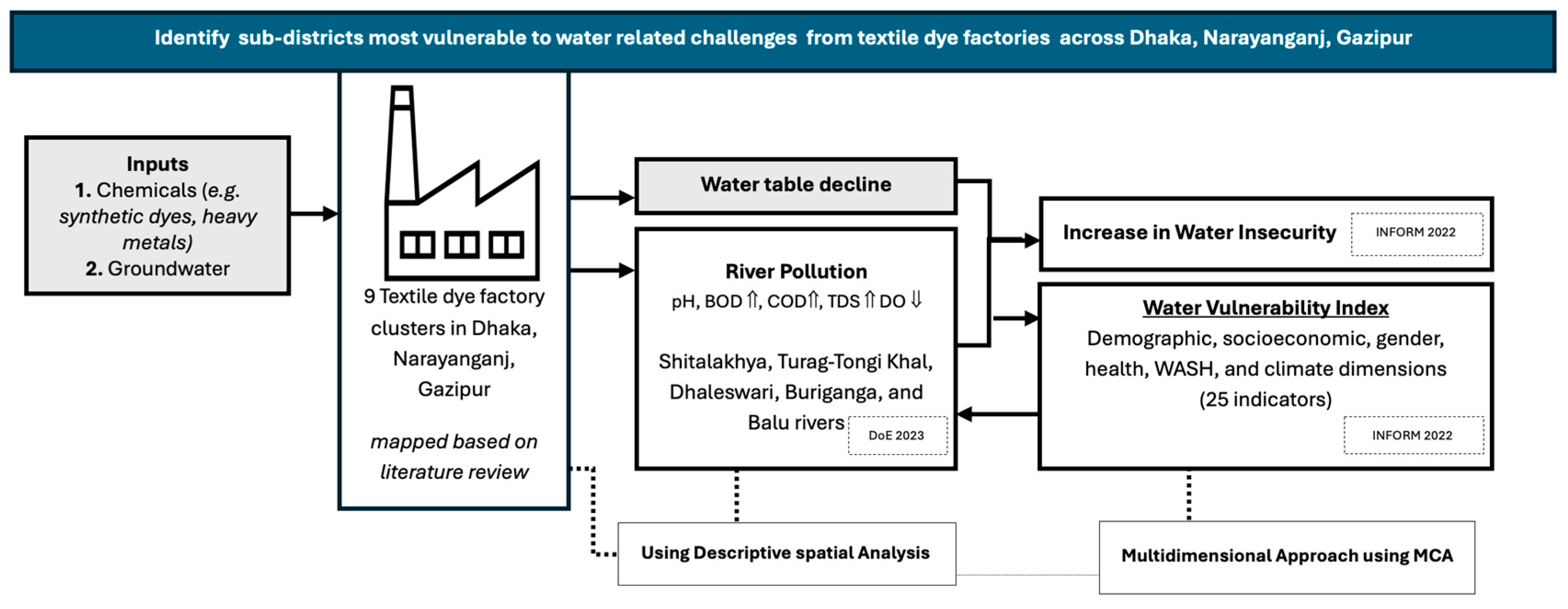

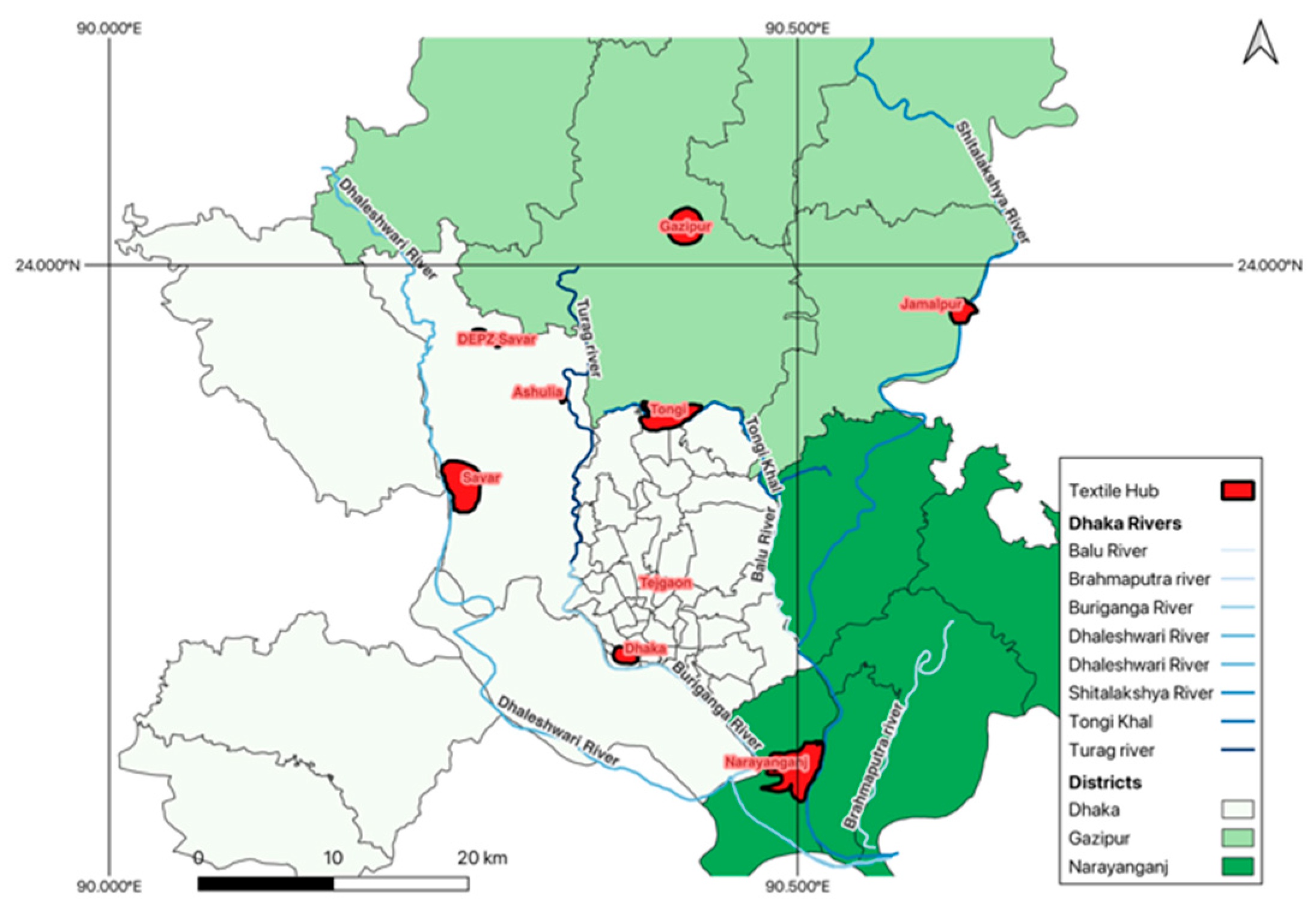
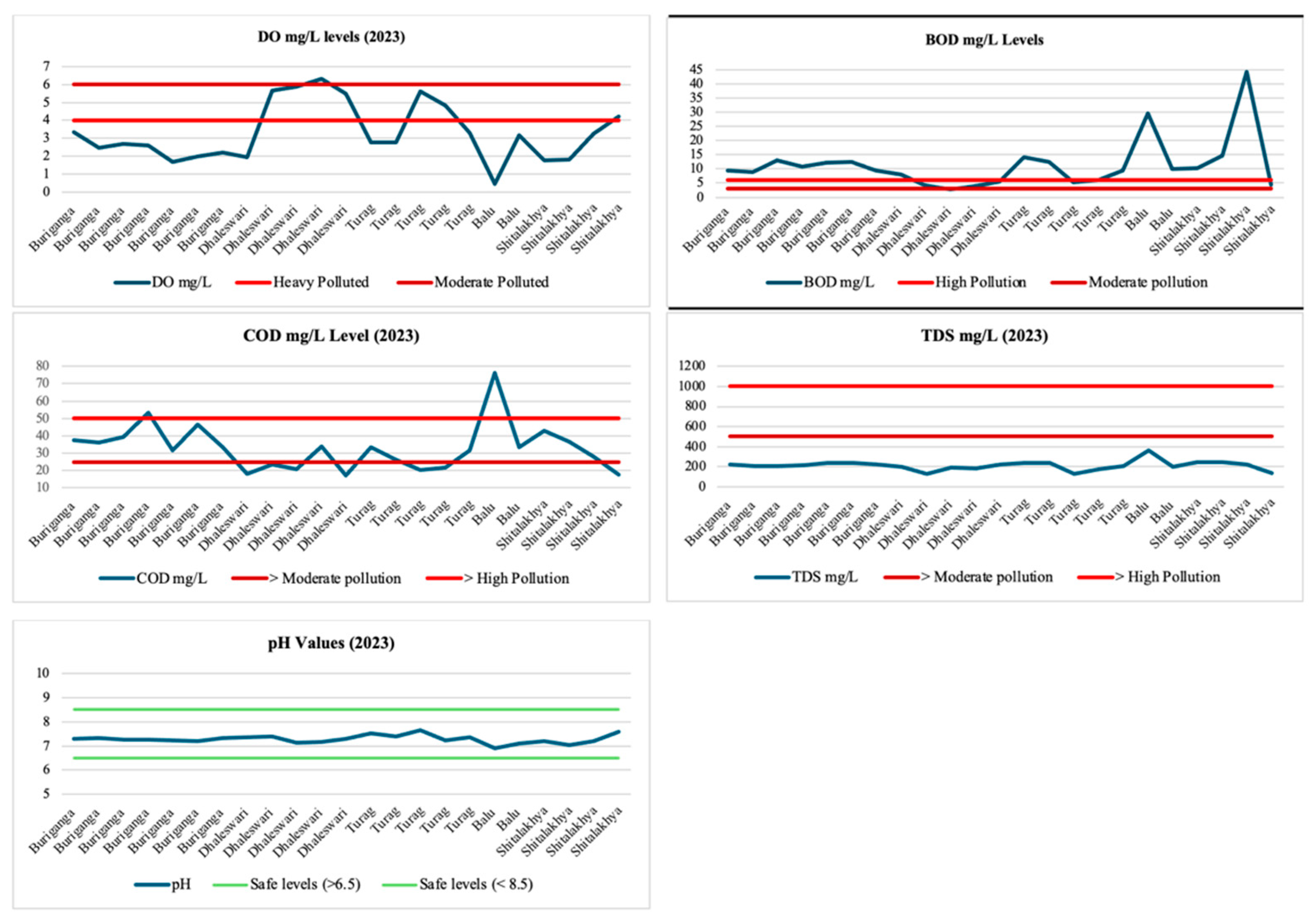

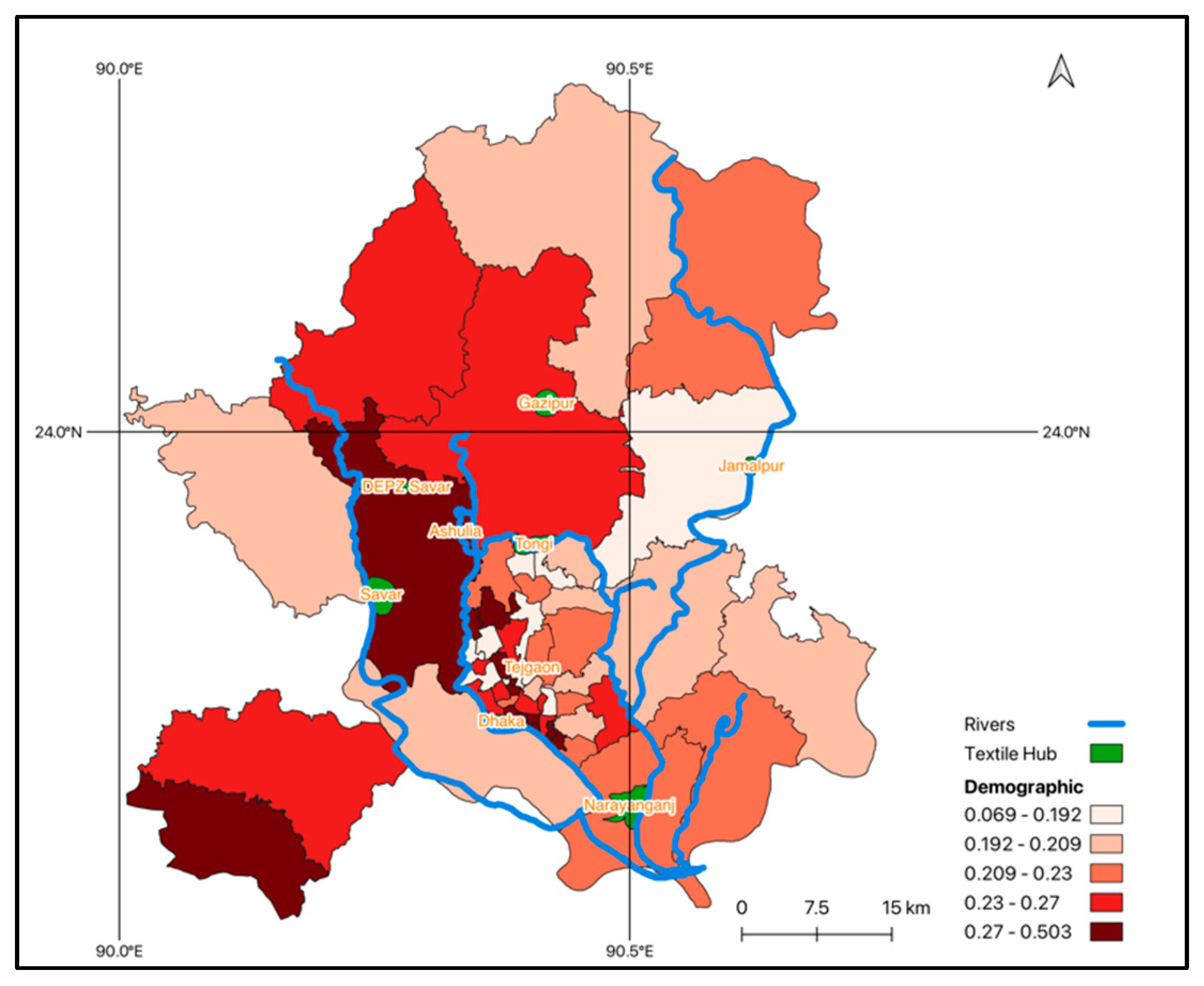

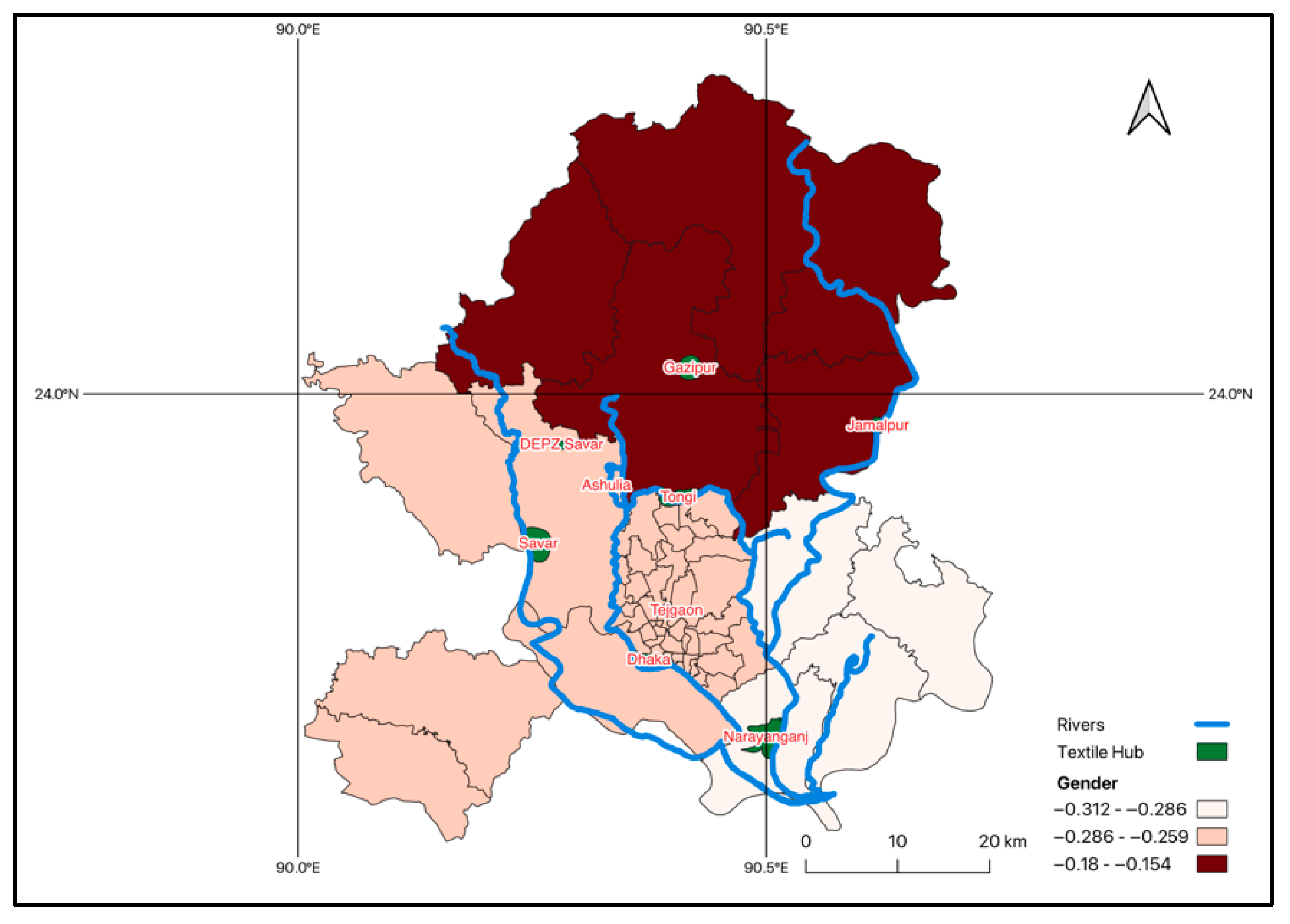



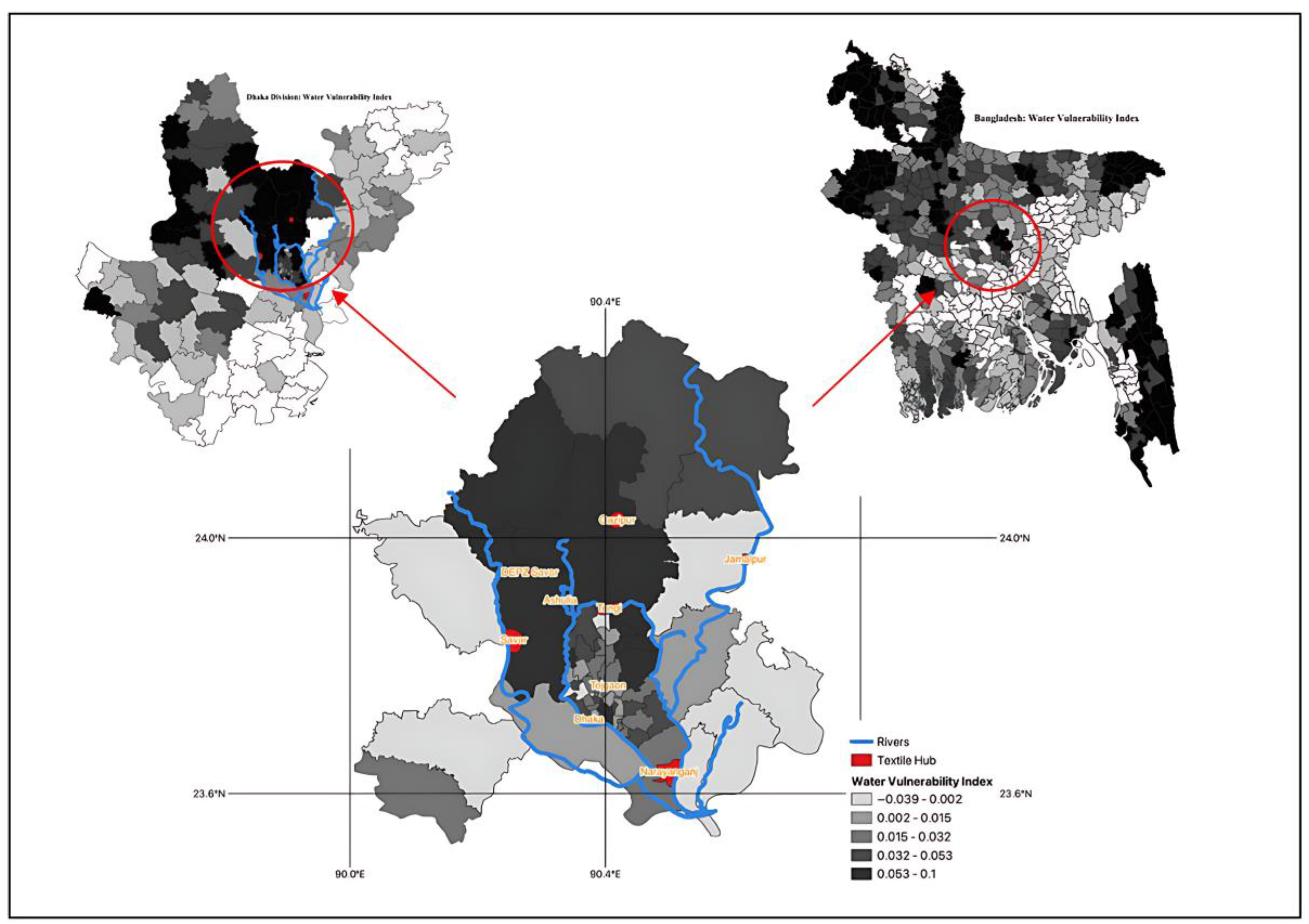
| Safe | Moderate Pollution | High Pollution | |
|---|---|---|---|
| pH | 6.5–8.5 | Higher or lower than 6.5–8.5 | |
| DO | Above 6 mg/L | 6–4 mg/L | <4 mg/L |
| COD | <25 mg/L | 25–50 mg/L | >50 mg/L |
| BOD | <3 mg/L | 3–6 mg/L | >6 mg/L |
| TDS | <500 mg/L | 500–1000 mg/L | >1000 mg/L |
| No | Indicator | Measurement/Definition | Source/Year | |
|---|---|---|---|---|
| Demographics | 1 | Population Density | Population/km2 ↑ | BBS 2021 |
| 2 | Population Living in Slums | The percentage (%) of urban dwellers living in slums ↑ | BBS 2014 | |
| 3 | Urban Population Growth | Annual % of urban population growth ↑ | BBS 2011-21 | |
| 4 | Woman-head household | % of women-headed households ↑ | BBS 2021 | |
| Socioeconomics | 5 | Income inequality | The ratio of the Gini from the income distribution ↑ | BBS 2020 |
| 6 | Poverty | % of poor households ↑ | BBS, WB 2017 | |
| 7 | Unsustainable Livelihood | % of population who live on unsustainable livelihood (Agri and non-Agri day labor) ↑ | BBS-HIES 2016 | |
| 8 | Unemployment Rate | A portion of the workforce is not employed ↑ | LFS-BBS 2022 | |
| 9 | Child Labor | % of children 5–17 years involved in child labor ↑ | MICS, 2019 | |
| 10 | Floating Population | % of the population with no permanent home ↑ | BBS, 2021 | |
| Gender | 11 | Domestic Violence Attitude | % of women’s (15–49) attitudes towards domestic violence ↑ | BBS 2019 |
| 12/13 | Gender Parity Index (GPI) for Secondary School | Net attendance for girls divided by net attendance for boys (secondary school) ↓ | MICS-BBS and UNICEF 2022 | |
| 14 | Menstrual Hygiene | % of women aged 15 to 49 years of the total population ↓ | MICS 2019 | |
| WASH | 15 | Basic Sanitation Services | % of population using basic sanitation services ↓ | WHO and UNICEF 2019 |
| 16 | Water insecurity | % of people having access to basic water services ↓ | BBS and UNICEF 2019 | |
| 17 | Open Defecation | % of population practicing open defecation ↑ | BBS 2021 | |
| Health | 18 | Under-5 child mortality | Per 1000 live births ↑ | BBS 2019 |
| 19 | Underweight | % of underweight children under 5 years ↑ | UNICEF 2019 | |
| 20 | Insufficient Early Child Development Index | % of children (36–59 months) not on track in three domains: literacy–numeracy, physical, social–emotional, and learning ↑ | UNICEF 2019 | |
| 21 | Physicians Density | The number of doctors per 100,000 population ↓ | DGHS 2022 | |
| 22 | Community Clinic Density | Number of community clinics per 100,000 people ↓ | DGHS 2022 | |
| Climate | 23 | Intensive River Flood | % of total area exposed to extensive river flood ↑ | BARC and BBS 2022 |
| 24/25 | Drought Risk | Physical exposure to extensive drought (Rabi and Kharip) (relative) ↑ | Inform 2022 |
Disclaimer/Publisher’s Note: The statements, opinions and data contained in all publications are solely those of the individual author(s) and contributor(s) and not of MDPI and/or the editor(s). MDPI and/or the editor(s) disclaim responsibility for any injury to people or property resulting from any ideas, methods, instructions or products referred to in the content. |
© 2025 by the authors. Licensee MDPI, Basel, Switzerland. This article is an open access article distributed under the terms and conditions of the Creative Commons Attribution (CC BY) license (https://creativecommons.org/licenses/by/4.0/).
Share and Cite
Rasmussen, K.H.; Setiawati, M.D.; Gomes, K. Water Vulnerability in Dhaka, Narayanganj, and Gazipur Districts of Bangladesh: The Role of Textile Dye Production. Water 2025, 17, 2475. https://doi.org/10.3390/w17162475
Rasmussen KH, Setiawati MD, Gomes K. Water Vulnerability in Dhaka, Narayanganj, and Gazipur Districts of Bangladesh: The Role of Textile Dye Production. Water. 2025; 17(16):2475. https://doi.org/10.3390/w17162475
Chicago/Turabian StyleRasmussen, Kamille Hüttel, Martiwi Diah Setiawati, and Kamol Gomes. 2025. "Water Vulnerability in Dhaka, Narayanganj, and Gazipur Districts of Bangladesh: The Role of Textile Dye Production" Water 17, no. 16: 2475. https://doi.org/10.3390/w17162475
APA StyleRasmussen, K. H., Setiawati, M. D., & Gomes, K. (2025). Water Vulnerability in Dhaka, Narayanganj, and Gazipur Districts of Bangladesh: The Role of Textile Dye Production. Water, 17(16), 2475. https://doi.org/10.3390/w17162475






